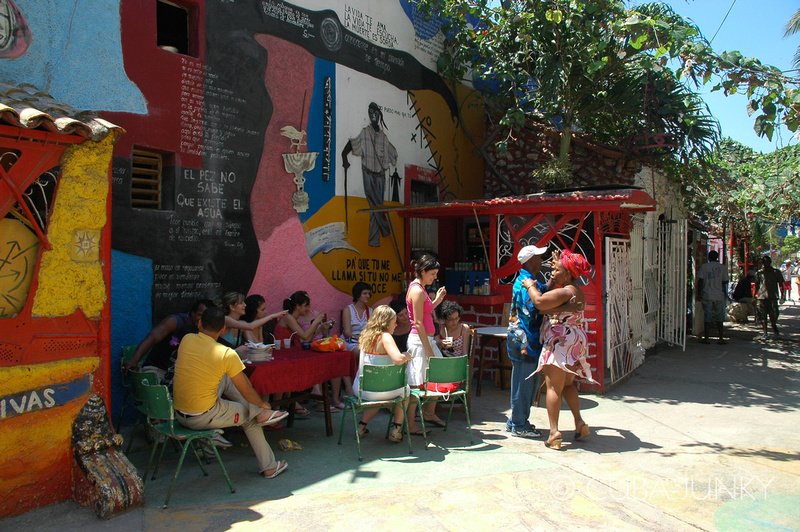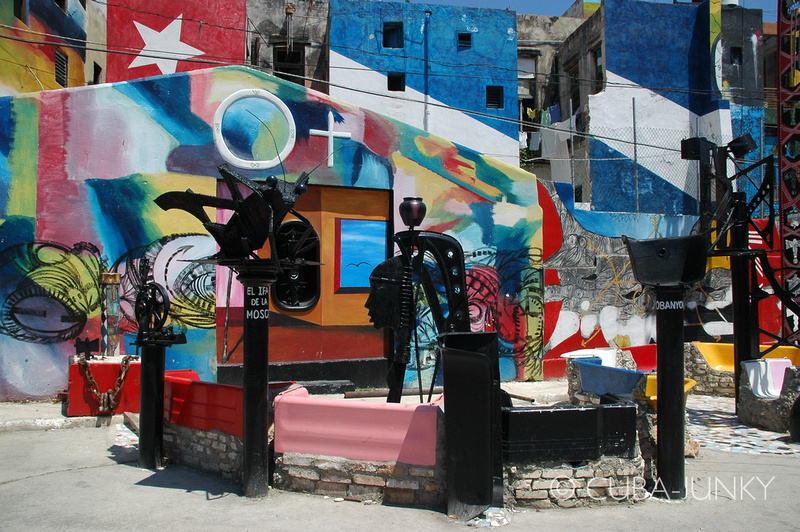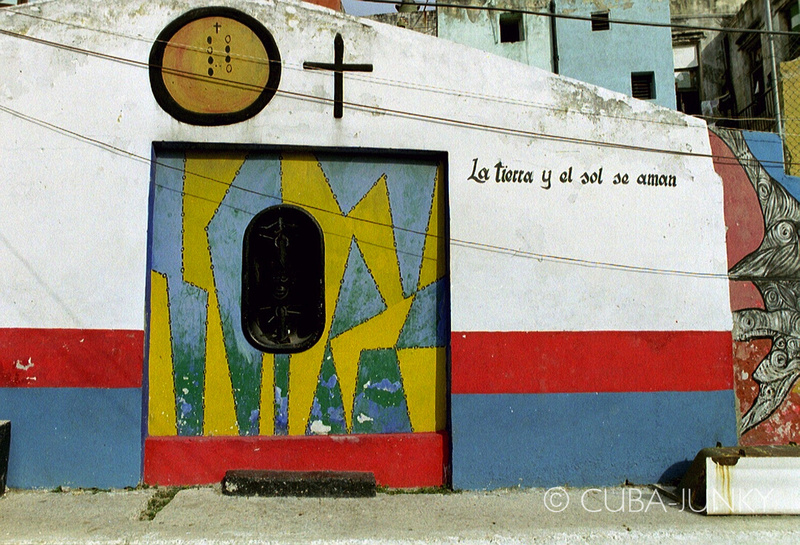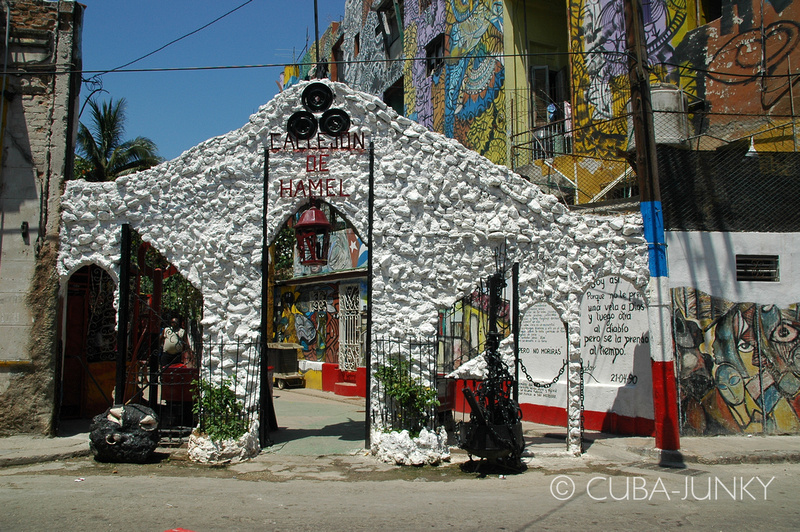Callejón de Hamel
Project of Salvador González Escalona
"In reality, the Callejón de Hamel is a heavy load of poetic images and sculpture that you have to live through, as you have lived it in the rumba, in all of the goings on that take place around it. This is, for many, a thing of magic, because it is the result of a conversation with the orishas over a period of many years. It's where you can see landing that white dove of Obbatalá that flies and flies and flies until it finds its place here."
|
|
|

"Its walls express in one form or another the feeling of African art, that is the presence of African culture in our country. You will find here pieces of sculpture, overhanging roofs with many colors, poetry, images. A house that could be a temple, or that is a temple for this community. It is Black poetry that is in each house, which is at the same time a temple."
"The barrio Cayo Hueso is a barrio of the people, with a great cultural force which has given rise to some magnificent artists. It is so called because in the past many people from Key West, Florida, lived here, mostly tobacco workers who wound up settling here. People in the area started referring to 'the people from Cayo Hueso,' cubanizing the Key West. From that came the 'barrio Cayo Hueso."
"We find here many of our best musical traditions. In this alley many years ago, in the 40's, a cuban musical movement was born, known as "filin," songs of feeling, with our friend Angelito Díaz and his now deceased father, Tirso Díaz. There were figures such as Elena Burque, the late Moraima Secada, aunt of Jon Secada, Omara Portuondo (featured in Buena Vista Social Club), César Portillo de la Luz, and many others."
"Here, the traditional comparsas (carnival street bands) of our barrio are very important. So too all the rumbas formerly played in Trillo Park. This is also a place steeped in popular religion. You can walk down the street and hear a 'toque'. Abakuá plants (for initiations) are found all over. The barrio has its own 'potencia' of the secret Abakuá religion, very important here."

"I am talking about the religion known as Santería, which comes from the Yorubas; Palo Monte, which comes from the Congo; Abakuá, which has to do with Calabar [the Cross River Delta in Nigeria]; and maybe some manifestations of spiritism, a cultural expression of working class people, the ordinary folks in our country."
"This barrio has a strong contingent of Black people. Of course, we don't have all of the Black people in the city here. Our country is a mixture of African, Spanish, and Asian presences. The barrio looks great, with many colors that shine even more now that there has been some remodeling. In one way or another, this work that we began here in Centro Habana has resulted in the same kind of color and magic that the barrio has to begin with."
"In the decades of the 40's and the 50's this musical movement rose up in the house of Tirso Díaz where a group of young people got together who are now stars of Cuban music. But that movement did not grow further there and the Callejón de Hamel stayed in the dust, forgotten in time. It was in 1990 when I set myself the task of beginning to paint these walls. As I painted, I saw how the alley was growing. I saw how interesting things came up, how it was becoming converted bit by bit into a monumental work. And monumental works deserve respect. So I began to revere this respect and people then began to interiorize this."
|
|
|

"Not even I knew I was transforming myself into one of the pioneers of the theme -- although great masters such as Wifredo Lam had painted murals, they were painted inside houses. But as to outside murals, maybe fate reserved this little piece for me. And that's how we get this mural on a public street. People's reaction was magical. Many knew the work it took me to find the materials and told me 'Maestro, I have in the house a little bit of red oil paint,' or yellow, or a little printing dye. And so it was that I began to paint with whatever I came across. At that time I still hadn't traveled outside of Cuba. It's for this that I love this work so much, it has achieved such an international recognition, it is known in a lot of places. It is from this work that I travel abroad. I'm not giving thanks because this got me abroad, I give thanks because I have been able to take out our culture, which is AfroCuban culture."
"Loíza is a very important Black community in the northwest of the island, where they play rumba. It's like I'm bringing over the rumba of the Callejón de Hamel as a gift to the rumba of Loíza. I painted another mural in San Sebastián street, in a place they call Rumba because there at night you can hear the drums and cajones [wooden boxes used as drums]. The last one I made was in a community called La Perla, a very humble community near Old San Juan. In La Perla, they know a lot about African culture. I experienced these places and for that I wanted to give them a mural with all the love and care of a Cuban artist. It's really great to see how you can re-create your culture in other places and how, from the mural work, you can establish these links around the world."

"There are artisans and plastic artists who don't know these themes and dare to intrude on them. But they only do that in order to sell. Of course, for foreigners who don't know our culture, who have only heard of Voudu and confuse it with Santeria, when they come to Cuba, they look for the exotic side of this theme. They encounter certain people who sell them images of the orishas (Yoruba dieties) and talk to them of Elegguá, Changó, or Yemayá, without any grounding, that is without any preliminary study before executing the work. I don't want to say that's the case with everyone. The are excellent artists whose work is well grounded. And I add myself to them. I think you have to start with a work whose values are well grounded for our culture to be preserved and our traditions maintained. In this way our image, which has traveled through time, gives faithful proof of our true identity as a people. This is the great importance that Callejón Hamel holds for us, it preserves those values which for many are archaic, primitive, but which nevertheless have their origin in one of the oldest cultures on earth -- the Yoruba culture which in Cuba is lived at the threshold of the third millenium, with a living ritual, with living consecrated drums, with living elements of a strong cultural identity which prevails in our food, in our education, in our manner of speech, in our way of talking, in the way we express ourselves. Here the values of a cultural identity are intrinsic. Taking care of this, preserving this, we attain what our don Fernando Ortíz said:
'Every people who denies themselves is thereby in danger of a suicide trance.'
The thing is not to deny ourselves, but to fight on."
I, Cuba-Junky as myself and Hija de Obbatalá get very inspired by a man like Salvador Gonzáles.
Thank you Salvador

Salvador González Escalona
Born: Camaguey 1948
Painter, Muralist, Sculptor
Asesor de Arte Popular
Metals Technologist
Died: April 16 2021 in Havana Cuba
Callejon de Hamel
San Lazaro # 955
E/ Aramburu y Hospital
Centro Habana, Cuba
Photo Gallery Callejon de Hamel
|
|
|
|
|
|
|